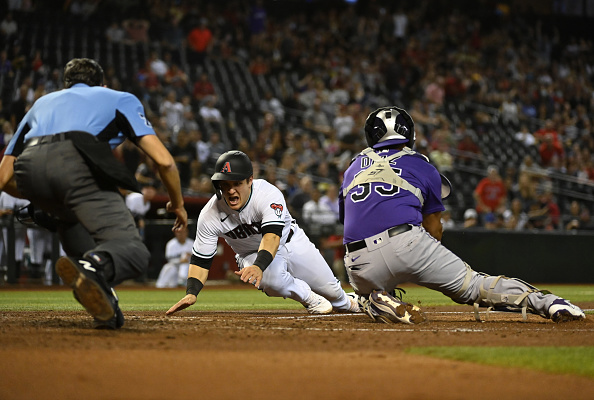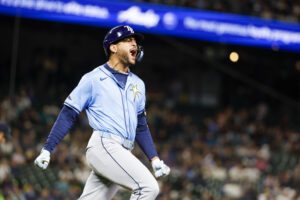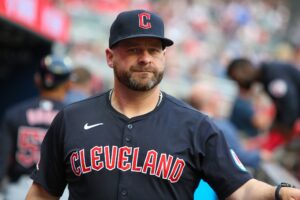Daulton Varsho and Where He Will Play Defensively
The Arizona Diamondbacks have in Daulton Varsho a player type that does not come around every year. Varsho might not even be the type of player who comes around every decade, in fact. He is a catcher with the speed and reaction time to also play center field. With his contact skills and running ability, he is someone managers make sure to keep in the lineup.
Catchers get more days off than the other positions, simply due to the demand it places on the body. Varsho, however, is not the type of player managers like to give days off to. Furthermore, since Carson Kelly is a steady presence at catcher, Varsho is already the backup.
Varsho struggled at the beginning of 2021. Entering the Sunday, July 11 game against the Los Angeles Dodgers at Dodger Stadium, his season slash line was .138/.250/.175 (11-for-80) with three doubles, a .207 wOBA, and -8.2 wRAA. His first two at-bats resulted in outs, dropping his slash line to .134/.245/.171 (11-for-82). He had not homered since September 15, 2020. His third at-bat in that July 11 game snapped the homerless drought. From that game onward, he slashed .289/.347/.539 (59-for-204) with 14 doubles, two triples, 11 homers, 33 RBI, and 33 runs scored. This gave him a .370 wOBA and 10.3 wRAA over that span. General manager Mike Hazen, in the end-of-season press conference, said that Varsho was one of the team’s most dynamic players.
Historical Comparisons to Daulton Varsho
As mentioned before, Varsho is someone the Diamondbacks want to keep in the lineup. There were other catchers who had entered the league with speed and contact ability. Two from the 80s and 90s are Craig Biggio and Jason Kendall. Biggio entered the league in 1988 as a catcher for the Houston Astros, then part of the National League. In 1990, Biggio split time between catcher and the outfield, playing around 2/3 of his games at catcher. He caught almost exclusively in 1991 before moving full-time to second base in 1992. For the 16 remaining seasons of his career (1992–2007), Biggio played second base in 14 of them. In the other two, he was in the outfield. This move preserved his health for his career, leading him to the 3000 Hit Club (3060, to be exact) and a 2015 Hall of Fame induction.
Kendall debuted with the Pittsburgh Pirates in 1996, beginning a 15-year career. He was a catcher for his entire career, one that saw him play for the Pirates (1996–2004), Oakland Athletics (2005–07), Chicago Cubs (2007), Milwaukee Brewers (2008–09), and Kansas City Royals (2010). Kendall was a threat to hit triples and steal bases, at least while he was with the Pirates. Once he joined the Athletics, his numbers dropped. Speculation arose that the 10th-year player, who turned 31 in June of that season, had taken too much of a beating behind the plate — especially his knees, from all the squatting.
Which Career Template — Biggio or Kendall?
This raises a career question for Daulton Varsho as to whether he will follow the template of Biggio or Kendall. When asked about this in late September of 2021, Diamondbacks manager Torey Lovullo said of this of Varsho. “We’re still trying to figure out what the best path forward is for him. He’s a special player —a young, talented player that has a chance to be very special. And we want to maximize his potential to be as good as he can possibly be.” Lovullo added that Varsho is a “very, very fast baseball player” and that the coaching staff was “very well aware of the fact that, at some point in time, the legs might wear down a little bit.”
When asked if he sees Varsho in the mold of either Biggio or Kendall, Lovullo thought and then smiled a bit. He replied, “I’ve thought a lot about Craig Biggio when I’ve watched (Varsho). Biggio ran extremely well, and they maintained his speed by putting him (at second base and then) in center field. Jason Kendall was a very good runner for the majority of his career. Brad Ausmus is another one that comes to mind. But I’ve connected him a lot to Craig Biggio because it’s two premium positions in center field and catcher.”
Input from Coaches
Shortly after the press conference where Lovullo said this about Varsho, then-catching coach Robby Hammock was asked about Daulton Varsho and moving positions to save his knees. Hammock said, “A lot of it is probably going to be offensive. If Daulton’s numbers can keep up, then you’re basically going to put him wherever he’s needed.”
Hammock added that some of it will depend on what happens with injuries and off-season signings. If the team picks up another catcher that can back up starter Carson Kelly while still producing from the plate, Varsho could go to center field. And if the team finds an outfielder, Varsho could catch more. However, Hammock warned that it’s still early in Varsho’s career. “None of this stuff’s set in stone,” he said, “and I still think it’s too early to even try and make a decision on it right now. It has to play itself out to really make any plans. I do understand that, historically, guys who catch slow down and their offensive production wavers a little bit, aside from a few anomalies. But it’s going to depend on need and what can transpire.”
Dave McKay
First-base coach Dave McKay, who also works with the outfielders, agreed with Hammock. It’s still early enough in Varsho’s career that he can be used defensively wherever he’s needed to provide the best offensive matchups. McKay said that the defensive decision on Varsho will probably come “two, three years down the road.” He added, “You need to keep yourself thinking about it. When you start realizing that there’s a real upside to his offense and running, and that he’s a great outfielder, then you have a decision to make. Because down the road, there could be some wear and tear. You hear of catchers losing their legs after catching a lot.”
McKay also coached against Kendall during the latter’s entire time in Pittsburgh, since McKay was with the St. Louis Cardinals. He recalled that Kendall “had a little taken away from his feet” due to the physical demand of catching. He added, “Sometimes (catchers) start to lose the offense, too.” But with Varsho, McKay said, “This is early. Right now, (Varsho) is getting some playing time, which is what he’d like to do the most. Not catching every day. If catching is all you do, then you’re playing once or twice a week. So (switching between positions) is a good way to get him on the field. (We) get him playing, get him active.”
McKay agreed that, other than Varsho being in the outfield and Biggio mainly in the infield, there are similarities between the two. “They both run very well and are both very smart players. I’m sure Biggio could have been an outstanding catcher. But (the Astros) decided to keep his legs” and move him to second. McKay added that he did not know how that decision came down, but he noted that there are similarities.
Outlook for Daulton Varsho
The managerial and coaching staff has confirmed that this all still holds true for the 2022 season. When it comes to where Daulton Varsho plays, keeping his bat in the lineup will be the priority. Varsho likes both positions equally, noting that each brings its own challenges, all of which he enjoys. As McKay put it, “He’s loving it. We’re loving seeing him out there and getting to see more of him and what he can do. And then maybe later, rather than sooner, we might have to sit down and have that discussion.”
Until then, fans can sit back and enjoy watching what could be the start of a special career.
Main Photo:
Players mentioned:
Daulton Varsho, Carson Kelly, Craig Biggio, Jason Kendall, Torey Lovullo, Brad Ausmus, Robby Hammock, Dave McKay






